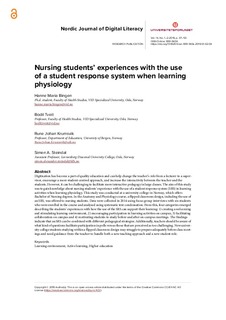| dc.contributor.author | Bingen, Hanne Maria S | |
| dc.contributor.author | Tveit, Bodil | |
| dc.contributor.author | Krumsvik, Rune Johan | |
| dc.contributor.author | Steindal, Simen Alexander | |
| dc.date.accessioned | 2020-01-15T09:51:06Z | |
| dc.date.available | 2020-01-15T09:51:06Z | |
| dc.date.created | 2019-06-05T10:53:31Z | |
| dc.date.issued | 2019 | |
| dc.identifier.citation | Nordic Journal of Digital Literacy. 2019, (1-2), 37-52. | |
| dc.identifier.issn | 1891-943X | |
| dc.identifier.uri | http://hdl.handle.net/11250/2636361 | |
| dc.description.abstract | Digitisation has become a part of quality education and can help change the teacher’s role from a lecturer to a supervisor, encourage a more student-centred approach, and increase the interactivity between the teacher and the students. However, it can be challenging to facilitate more interactive pedagogy in large classes. The aim of this study was to gain knowledge about nursing students’ experience with the use of a student response system (SRS) in learning activities when learning physiology. This study was conducted at a university college in Norway, which offers Bachelor of Nursing degrees. In the Anatomy and Physiology course, a flipped classroom design, including the use of an SRS, was offered to nursing students. Data were collected in 2014 using focus group interviews with six students who were enrolled in the course and analysed using systematic text condensation. From this, four categories emerged describing the students’ experiences with how the use of the SRS can support their learning: 1) creating a welcoming and stimulating learning environment, 2) encouraging participation in learning activities on campus, 3) facilitating collaboration on campus and 4) motivating students to study before and after on-campus meetings. The findings indicate that an SRS can be combined with different pedagogical strategies. Additionally, teachers should be aware of what kind of questions facilitate participation in polls versus those that are perceived as too challenging. New university college students studying within a flipped classroom design may struggle to prepare adequately before class meetings and need guidance from the teacher to handle both a new teaching approach and a new student role. | |
| dc.language.iso | eng | |
| dc.rights | Attribution-NonCommercial-NoDerivatives 4.0 Internasjonal | |
| dc.rights.uri | http://creativecommons.org/licenses/by-nc-nd/4.0/deed.no | |
| dc.title | Nursing students’ experiences with the use of a student response system when learning physiology | |
| dc.type | Peer reviewed | |
| dc.type | Journal article | |
| dc.description.version | publishedVersion | |
| dc.source.pagenumber | 37-52 | |
| dc.source.journal | Nordic Journal of Digital Literacy | |
| dc.source.issue | 1-2 | |
| dc.identifier.doi | 10.18261/issn.1891-943x-2019-01-02-04 | |
| dc.identifier.cristin | 1702878 | |
| cristin.unitcode | 230,0,0,0 | |
| cristin.unitname | Lovisenberg diakonale høgskole | |
| cristin.ispublished | true | |
| cristin.fulltext | original | |
| cristin.qualitycode | 1 | |

